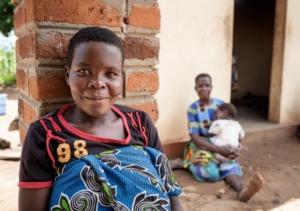The new role of traditional birth attendants: Stories from the field, Zambezia, Mozambique 25 March 2015.
Dorca Taulo gave birth to her first child 6 years ago in the house of the traditional birth attendant in her community in Milange, Zambezia. When she recently became pregnant again, Fany Pitala, her traditional birth attendant, accompanied her to the nearest health centre in Dachudua, Milange so she could give birth in a clinic.
I had my first son in Fany’s house, explains Dorca. She is the traditional birth attendant in my community in Mulepa. When I got pregnant again, she took me to the health centre here in Dachudua for ante-natal care. The last time we came, the nurses told me to stay in the maternity home because I live 10 kilometers away and I will give birth soon.
Institutional deliveries and skilled care before, during and after childbirth can save the lives of women and newborn babies. Zambezia province has some of the highest rates of maternal and neonatal mortality in Mozambique.
To give birth with a traditional birth attendant is risky, says Dorca. If mother or baby has problems, the traditional attendant does not have the conditions to solve the problems for example if you start to lose blood or get an infection.
To make sure that women get to the health centres for ante-natal care and in time for giving birth, a new collaboration between health centres and traditional birth attendants has been established. It is based on the unique network and cultural connection that traditional birth attendants have to rural communities.
As Dorca, many people in Zambezia live far away from health centres. Maternity waiting homes have therefore been built to accommodate pregnant women the last days of their pregnancy so they can give birth in a health centre with trained nurses.
After introducing this new methodology there are big changes, says Maternal and Child Health Nurse, Sinanoya Miranda. The traditional birth attendants now help sensitizing information in the communities about the benefits of giving birth in the maternity ward. In the past, the traditional birth attendants carried out the births at home and that created many problems for us because the women would arrive here exhausted after having begun to press before time.
To make sure women receive quality care when arriving at the health centres, maternal and child health nurses have been trained in essential obstetric care including ante-natal and postpartum care. Traditional birth attendants have also been trained to recognize critical symptoms of common diseases and encouraged to refer the women to the health centres.
We are six traditional birth attendants who cover the communities around Duchudua health centre, says Fany. Now that Dorca is staying in maternity home, I am taking turns with the other traditional birth attendants so there is always someone to look after her.
Fany and the other traditional practitioners meet monthly with the maternal health nurses to plan to the shifts at the maternity home and to share information about health in the communities they are covering.
When Dorca came to see me for this pregnancy, says Fany, we went together to Daduchua health centre for ante-natal care and to open the maternal health registration card. I will help her during the birth and after that we will return together to the community.
The MDG 4&5 project aims to improve maternal and child health with particular focus on Zambezia province. Four UN Agencies work together to make this project happen: WHO, UNFPA, UNICEF and WFP with funding from the Canadian Department of Foreign Affairs, Trade and Development. One of the goals is to increase demand for and improve quality of skilled care before, during and after childbirth.




